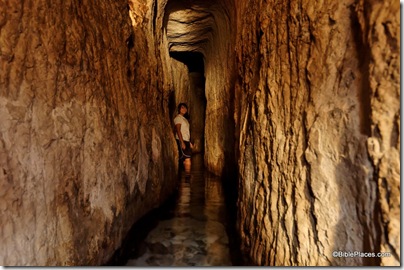The Sept/Oct 2008 issue of Biblical Archaeology Review carried an intriguing article that suggested that workers used sound signals from above in determining direction while carving Hezekiah’s Tunnel. The apparent “consensus” theory that they followed a natural crack always seemed implausible to me, and thus I am interested in learning of other possibilities.
A number of readers sent questions about the article and one of the scientists of the study responds in an online-only article. Questions that he answers include:
- How does Hezekiah’s Tunnel compare with the water tunnels of Megiddo and Hazor?
- How could sound signals pinpoint direction through more than 100 feet of bedrock?
- Did water flow uphill from the Gihon Spring to the Pool of Siloam?
- How were the workers supplied with oxygen?
- Isn’t there really a natural crack that the workers followed?
Ayreh Shimron has some good insights into these and other matters.

6 thoughts on “Hezekiah’s Tunnel Q&A”
I just want to know why you didn’t use the picture of Hezekiah’s Tunnel with me in it.
-Leo
Leo – sorry to cause offense. I just thought viewers would rather see more tunnel and less (of your) face!
I think Ayreh Shimron has a good idea here, but I think the matter is far from settled.
Of course, he defends the theory like he’s defending his sister’s honor. I don’t think he takes the remaining questions seriously enough.
I know I continue to be amazed at what the ancients were able to do with simple tools and strong backs.
Would they really have had a ‘good geological hammer,’ or whatever his exact words were, in antiquity? I’m ignorant as to what exactly that is, but it sounds rather modern. (That, according to his online article, is what they used to pound from the tunnel to earth and vice versa, to establish location.)
I have read the article and the comments here and the question I have relates to the statement of water flowing uphill. The natural crack theory might possibly allow for the flow of the water downhill but the sounds listened for on ground level would not allow for the elevation. What is the thinking on this issue.
For lay readers: Yes, water can flow uphill when under pressure, with capillary action, with a siphon effect, or a combination thereof. The Gihon spring was an intermittent artesian spring in karst topography, which gushed sporadically due to variable pressure. (Hebrew Gīḥōn גיחון) means ‘gushing’. If the original opening of the Gihon spring was sealed off during the time of digging the tunnel or later, to conceal it from potential enemies outside the city walls, the pressure could make water flow up through a small space (though not through the full-sized tunnel).
I’ve walked and waded through the tunnel, and the variable ceiling height (from having to duck to having ~5 meters of overhead clearance) was explained to us by our knowledgeable guide as possibly caused by workers initially following a wet rock fissure up and down in elevation, and then levelling out the water bed after so water would flow naturally by gravity.